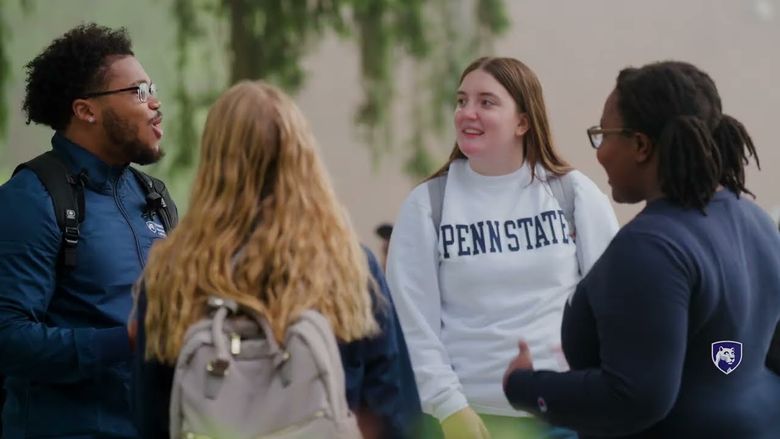

This dialog contains the full navigation menu for this site.

A blue Razzle sparked the one and only disagreement between Marla Stoner and Alyssa Hatter, best friends since the age of eight, when Stoner gave the tasty candy to another third grader. Hatter, then crestfallen, said she recovered from the childhood slight within an hour.
Both Hatter and Stoner, now at Penn State Schuylkill, along with classmate Casey Gregory—all rising juniors in the fall and biology majors—embarked on a trip to Costa Rica in May through the University’s CHANCE program (Connecting Humans through Nature and Conservation Experiences). All the students agreed that the bus ride from San Jose was a bit bumpy with “insane traffic”—a trip that took four hours in what should have been an hour and a half drive.
But the trip soon grew more interesting. “We spent four days of our trip exploring the country through extracurricular activities and five days working on a project paired with a scientist,” Stoner said.
The students, housed at La Selva, a Costa Rica research station in a protected rainforest, were encouraged to maintain a life list log to catalog the variety of living species in the tropical rainforest that they observed on a daily basis. “I finally stopped recording entries in my journal as it seemed never ending, but the diversity of the lifeforms is very impressive,” Stoner noted. Hatter and Stoner’s research focuses on bees on the Schuylkill campus. Hatter said, “The only bees we saw in Costa Rica were small orange-colored bees that did not sting; we liked that characteristic!”
“The first day we went on a hike and a boat ride that ran through the Sarapiqui River,” Hatter said. The next day they visited a coffee plantation and a pineapple plantation. “The coffee plantation is really sustainable with every part of the coffee plant, including the coffee bean, being used,” Stoner said. “The pineapple plantation was organic and they had tractor rides and offered free pineapple juice, fresh upside down cake, empanadas and more,” she added.
Gregory ‘s research team, under the faculty mentorship of Marcelo Araya, Ph.D. candidate, hypothesized that smaller birds have shorter unit durations and overall longer songs than larger birds that have larger unit durations and shorter songs. “We used a big leaf parabola to record the songs of three species of male hummingbirds while courting female hummingbirds.” Gregory said the hummingbirds, tiny and dull in color, were territorial when in a lek, a traditional place where two or more males assemble during the mating season to attract females through competitive displays, including performing songs.
The data gathered on the hummingbirds included frequency and wavelength of the sounds. “We collected data and used a spectrogram in the lab for statistical analysis,” Gregory explained. Their hypothesis was supported.
Stoner and Hatter’s team had mixed results. With rain boots over their leather boots, their team went deep into the forest to study disturbances to riparian forests near streams, rivers and flowing water. Riparian forests are protected by law and prevent pollution and erosion entering the waterways. “The disturbances to the riparian forest include flooding and chocolate—Theobroma cacao,” Stoner said, both potential disturbances that might negatively affect regeneration.
Twelve years ago the team’s faculty mentor, Dr. Amanda Wendt, the Organization for Tropical Studies Education and Research Liaison at La Selva, conducted research that provided the team with baseline data. “We were charged with counting the seedlings and saplings of small woody plants,” Hatter explained. She added that the cacao had been cleared and was regenerated over time.
According to Stoner and Hatter, there was not a significant difference due to regrowth of the cacao as the removal itself had resulted in more sunlight and optimal conditions to thrive. However, when analyzing the data collected on seedlings and saplings based on flood conditions, they noted a significant difference in the number of seedlings and saplings since the last count 12 years ago.
Stoner said that had her team worn Fitbits, they would have likely found out they walked about 15 miles per day. They felt well prepared for this project as they similarly work hard in a physically demanding environment while conducting their bee research on the Schuylkill campus with Dr. Brenna Traver.
On the last day of the trip, the student research teams presented their findings and fielded questions from the faculty mentors, research scientists and other students at a research symposium. They addressed not only their findings, but also how they might change the scope of their projects if they were to begin anew.
A variety of reptiles, sloths, wild boors, red-eyed frogs, bullet ants, peccaries, and more were observed by the students. “The guides were quick to let us know what lifeforms were in the vicinity,” Hatter said.
The students appreciated the opportunity to explore Costa Rica on this eye-opening adventure. Gregory said, “The trip made me realize that we need to conserve the rainforest now as there is so much life at stake,” A THON participant and a cross country runner at the Schuylkill campus, she said she appreciates the small class sizes and the personal relationships she has with her professors that will help her succeed in graduate school. Her research on the Schuylkill campus with Dr. Lucas Redmond focuses on gray catbirds.
Unanimously, the trio agreed that they would return to Costa Rica in a heartbeat. They said they enjoyed learning about the culture, getting to know the students and teachers in the program, the beauty of the rainforest and contributing to a more sustainable planet.
Sixteen students from various Penn State campuses made the trip along with professors, high school teachers and CHANCE Director Dr. Jacqueline McLaughlin from Penn State Lehigh Valley.


